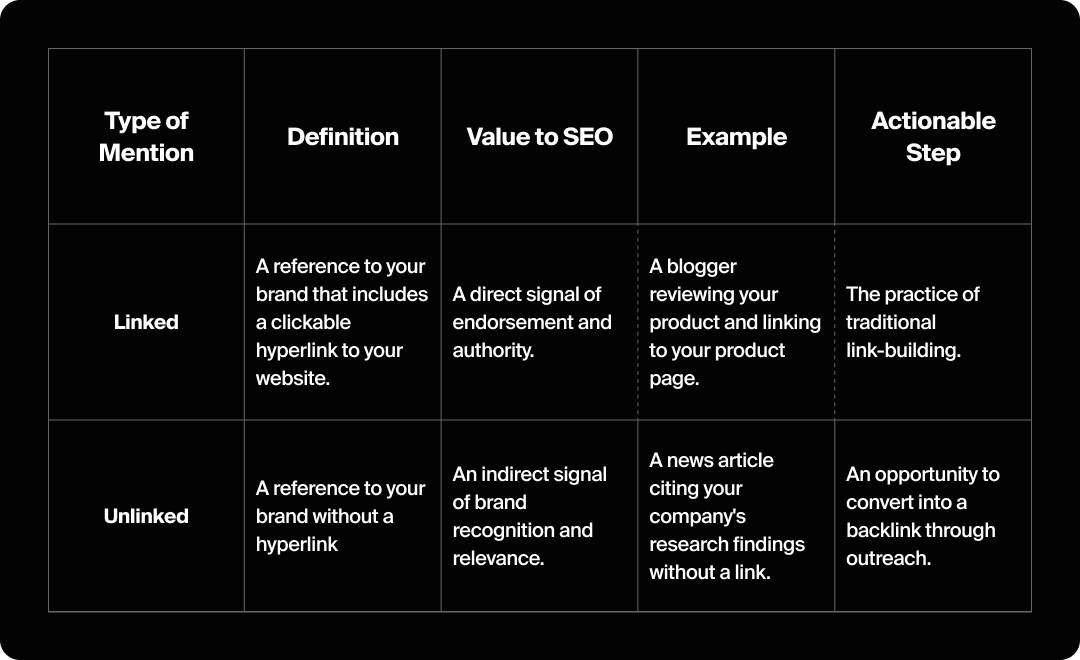If you thought that targeting strategic keywords and building a hefty backlink profile would carry your SEO strategy, you’re wrong. While these are still important strategies for improving visibility, Google’s algorithms have evolved to emphasize brand signals and user behavior (meaning you should, too!).
To give it to you straight, SEO is now less about gaming the system (no black hat SEO over here) and more about building a reputable brand that search engines can recognize as an authority. This guide will move beyond the traditional playbook and break down brand mentions and digital PR, why they’re important, and how to effectively strategize for them.
What Are Brand Mentions & Digital PR?
For years, backlinks were king for SEO; the more high-quality links you acquired, the higher you’d rank. While backlinks are still important, Google is starting to focus more heavily on brand signals, authority, and trust. This is where the power of brand mentions and digital PR comes in, rounding out your holistic approach to SEO.
What Is a Brand Mention?
A brand mention is any online reference to your brand, company name, product, service, or even employees. These mentions can take many forms and appear across various online platforms, from news sites and blogs to social media and review platforms.
There are two different types of brand mentions:
- Linked Mentions: This is the traditional backlink we’re all familiar with. It’s when a website references your brand and includes a hyperlink that directs users to your site. This is a signal to search engines that another site is endorsing your content or authority.
- Unlinked Mentions: This is a reference to your brand without an active hyperlink. For a long time, these were considered less valuable than backlinks, but Google’s algorithms are now sophisticated enough to recognize the value of these mentions.
Consider these real-world examples:
- Linked: A tech blogger writes a review of your new software and links the name of your product to your website’s product page.
- Unlinked: A reputable news outlet publishes an article on industry trends and cites your company’s recent research findings, mentioning your company’s name but not including a link.
- Social & User-Generated: A satisfied customer shares a picture of their new purchase from your brand on Instagram, tagging your account.
As Google’s algorithms are designed to understand context, it can infer that your brand is an authority on that topic, even if it’s unlinked. This is an often overlooked opportunity for SEO professionals to build authority without solely focusing on link acquisition.

What Is Digital PR?
Digital PR is the process of using online channels to build brand visibility and acquire high-quality placements.
Think of it as public relations specifically for the internet, with a clear focus on measurable SEO benefits. While traditional PR often aims for brand awareness through media hits, digital PR is designed to earn placements that not only build brand authority, but also generate valuable backlinks and brand mentions.
Common digital PR tactics include:
- Securing Media Placements: This involves writing compelling press releases, pitching commentary to journalists, and responding to media requests (e.g., via HARO) to get your brand featured in articles and news stories.
- Guest Blogging on Authoritative Sites: Instead of just getting a link, this strategy involves contributing original content to a well-known publication in your niche. This builds your brand’s reputation as a thought leader and earns a valuable backlink.
- Creating Linkable Assets: This is about producing content that people want to reference. Examples include original research, comprehensive infographics, data visualizations, or interactive tools. These assets act as “link magnets” that naturally attract mentions and links.
- Influencer Collaborations: Partnering with influencers in your industry can result in mentions across social media platforms, blog posts, or videos. These endorsements have the potential to reach new audiences and serve as a strong brand signal to search engines, making them a win-win.
Why Are Brand Mentions Important?
While backlinks are still vital, modern SEO requires a more nuanced approach. Brand mentions have become a critical component because they provide search engines with signals that are increasingly central to how content is ranked and presented.
Entity Recognition & H-E-E-A-T
Search engines like Google are designed to understand real-world “entities“, which consist of people, places, things, and, most importantly, brands. Brand mentions help search engines connect the dots, recognizing your company as a distinct entity with a digital presence.
Mentions also directly contribute to Google’s H-E-E-A-T (Helpfulness, Experience, Expertise, Authoritativeness, and Trustworthiness) signals. When a trusted news source or a respected publication mentions your brand, it’s an indication to Google that your brand is authoritative. It’s a signal of trust and credibility that can’t be faked, making it an influential ranking factor.
AI Search & SERP Features
With the rise of generative AI, brand mentions have taken on a new level of importance. AI models, like those powering chatbots, are trained on vast amounts of data from the web. They are designed to synthesize information from the most reputable sources to provide concise answers. When your brand is frequently mentioned in authoritative publications, it increases the likelihood that it will be cited as a source or included in an AI answer.
A strong brand presence also improves your chances of appearing in prominent SERP features like Featured Snippets, Knowledge Panels, and the People also ask box. When Google recognizes your brand as an established entity, it’s more likely to display these features for your branded searches and related queries, giving you a competitive edge.
Branded Search & Direct Traffic
Probably the most compelling argument for the importance of brand mentions is their correlation with branded search queries and direct traffic. As your brand’s name is mentioned more across the web, brand awareness grows. This leads to more users searching for your company by name (hello, branded search traffic!).
Branded searches signal to Google that users are actively seeking out your brand, indicating trust and relevance. This increase in branded search volume and direct traffic from users typing your brand name or URL is a direct result of effective brand-building and is a strong indicator of brand authority.

How To Increase Brand Mentions
The most successful brands don’t just wait around hoping someone talks about them; they utilize a strategic approach to build their authority.
Create “Linkable” Assets
Standard blog posts are good for attracting organic search traffic, but they usually don’t generate unsolicited mentions. To earn brand mentions from authoritative sources, you need to create “linkable” assets: content that people feel compelled to reference.
- Original Data & Research Studies: Nothing attracts a mention quite like unique data. Conduct surveys, analyze proprietary data, or publish a detailed industry report. When journalists, bloggers, or researchers need to cite statistics, your original research will become their go-to source, leading to mentions and links.
- Comprehensive, Interactive Guides & Tools: Go beyond a basic blog post. Develop an interactive tool, or an “Ultimate Guide” that becomes the definitive resource on a topic. These assets are frequently cited as a resource for their utility and depth.
- Controversial or Unique Perspectives: Don’t be afraid to take a stance. While it’s a riskier strategy, publishing a well-reasoned, contrarian viewpoint on an industry topic can spark debate, leading to mentions as people react to it.
Digital PR Campaigns
Digital PR campaigns can either make or break your brand, so to do them right, you need to understand how to do them.
- Identify Your Target Audience & Publications: Before you pitch, understand who you’re trying to reach and where they get their information. Create a list of relevant journalists, editors, and bloggers who write about your industry.
- Craft Compelling Pitches: Journalists receive hundreds of pitches a day, so yours needs to be concise and compelling. Focus on a catchy headline and a clear value proposition.
- Build Relationships: Successful digital PR is built on relationships, not one-off emails. Follow journalists on social media, comment on their articles, and show that you’re an engaged member of the community before you ever ask for a mention.
- Leverage Newsjacking: This is the practice of inserting your brand into a breaking news story or trending conversation. By offering timely commentary on a news event, you can get your brand mentioned in an authoritative publication that is already in the public’s eye.
Content Marketing & Thought Leadership
Your content marketing strategy is your primary tool for becoming a thought leader, which, in turn, organically generates brand mentions.
- Publish High-Quality Content: A consistent stream of insightful content on your blog or resource center establishes your authority over time. When your brand becomes known as a reliable source of information, others will naturally begin to cite you.
- Secure Guest Appearances: Pitch yourself or your company’s executives to appear as guests on relevant podcasts or panels. These appearances not only put your brand in front of a new audience but also almost always result in a written mention in the show notes or event summary.
- Encourage User-Generated Content: Your customers are your best advocates. Create campaigns that encourage them to share reviews, testimonials, or social media posts about your brand.
| Tactic | What You Do | Primary Outcome |
| Original Data & Research | Conduct surveys or analyze proprietary data to create unique reports. | Attracts mentions and links from news outlets and publications that need to cite data. |
| Comprehensive Guides & Tools | Create an in-depth, interactive guide on a niche topic. | Serves as a “link magnet,” getting cited as a definitive resource. |
| Guest Blogging | Contribute original content to an authoritative industry site. | Establishes your brand as a thought leader and earns a backlink. |
| Influencer Collaborations | Partner with relevant influencers in your industry. | Reaches a new audience and generates brand signals from trusted voices. |
| Securing Media Placements | Pitch compelling stories and commentary to journalists. | Results in high-authority mentions in news articles and press features. |
| Newsjacking | Insert your brand into a breaking news story with timely commentary. | Generates quick, high-profile mentions in relevant conversations. |
How to Use Brand Mentions & Digital PR
By integrating the following tactics into your SEO strategy, you can convert brand awareness into tangible ranking signals.
Monitor & Track
The first step in leveraging brand mentions is to know when and where they occur. You can’t capitalize on an opportunity you don’t know exists. For this, you’ll need to use a dedicated brand monitoring tool such as Goodie, Ahrefs Brand Radar, Semrush Brand Monitoring, or Mention.

These tools scan the web in real time for any reference to your brand name, products, or employees. By setting up alerts, you can receive notifications, allowing you to react quickly to both positive and negative mentions.
Goodie is an especially important tool for this because it measures your brand’s AI visibility. This means that Goodie tracks your brand’s mentions in LLMs, measuring how often it’s cited in each platform and the sentiment behind these citations.
Sentiment Analysis & Reputation Management
Brand monitoring tools also offer sentiment analysis, which categorizes mentions as positive, negative, or neutral. By analyzing sentiment, you can:
- Respond to Negative Mentions: A negative mention, left unaddressed, can spiral. By monitoring sentiment, you can quickly identify and respond to customer complaints or negative reviews, turning a potential crisis into a display of great customer service.
- Amplify Positive Mentions: Positive mentions from customers or industry leaders are great for amplification. Share them on your social media, feature them on your website, or use them as testimonials to build further social proof and credibility.
Your Next Move
As mentioned, SEO isn’t just about keywords and backlinks anymore; You have to build a brand. This means working actively for mentions and capitalizing on the moments you are being mentioned.
Building a brand isn’t a passive act, but a concerted effort. If you’re not sure where to start with this, our team of experts is at your disposal.





